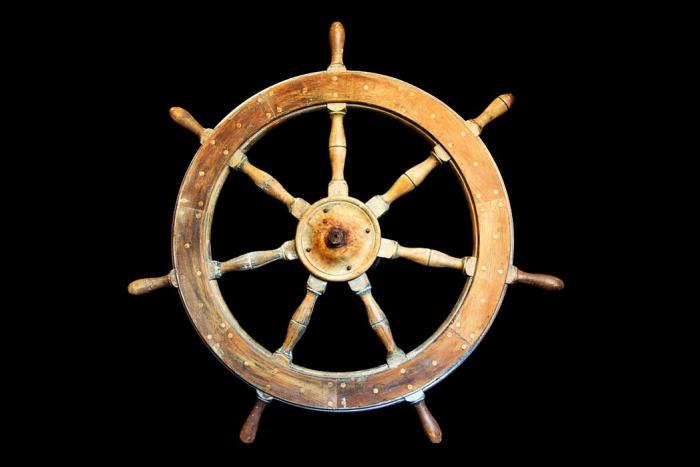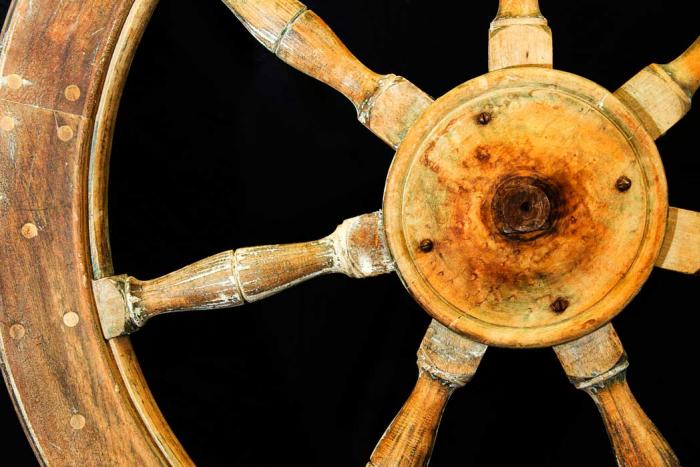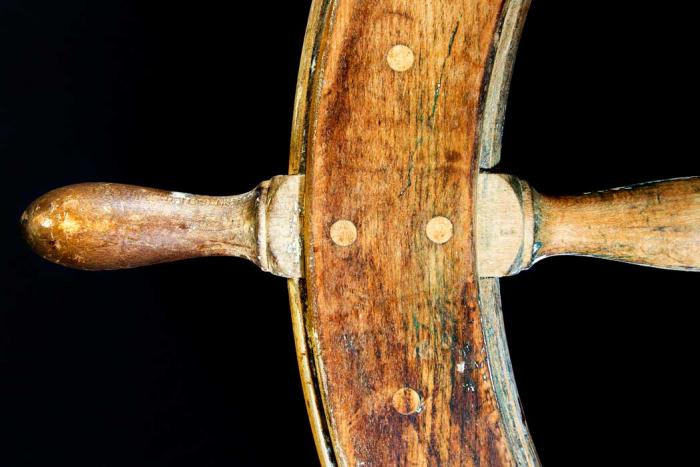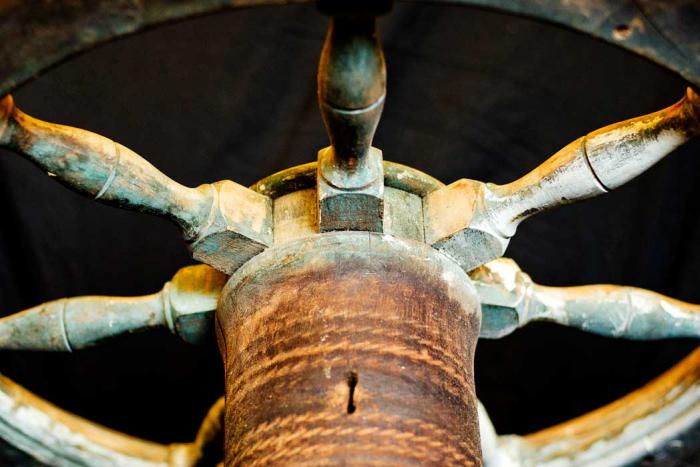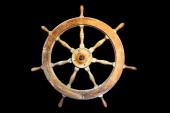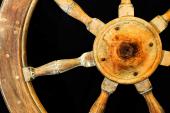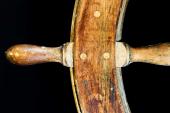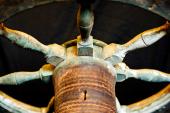Helm of the Norvic Ferry
Organization: Haughton’s Bay Museum
Address: 46 Bristol Road, Bristol, QC J0X 1G0
Region: Outaouais
Contact: Peter Haughton, bphaughton(a)rogers.com
Description: Helm of the Norvic Ferry from Norway Bay
Year made: 1923
Made by: Unknown
Materials/Medium: Wood
Colours: Natural
Provenance: Norvic wheel donated by Mary Calvert-Gamble, daughter of Captain William Dudley Gamble.
Size: 94 cm diameter
Photos: David Irvine. Courtesy Haughton’s Bay Museum
The Helm of the Norvic Ferry
Sandra Stock and Peter Haughton
Norway Bay, in the municipality of Bristol, on the Ottawa River, has been a second-home destination for many English-speaking families for over a century. Many people took the ferry, the “Norvic,” to reach Norway Bay from the train that travelled up the Ontario side of the river to Sand Point. The symbolic artefact for this community is a captain's wheel – the helm – of the Norvic.
The Norvic was launched from Sand Point, July 24, 1923, and started to operate July 28, 1923. It had one of the first semi-Diesel engines in the Ottawa valley, a 60 horse-power “Bolinder's,” that had been shipped from Sweden. This was replaced in 1951 by a General Motors 120-horse-power diesel. The Norvic plied the crossing from 1923 to 1963 and landed at the Norway Bay wharf. The ferry ran from early May through mid-October. On week-ends it would run until 10 or 11 o’clock at night. The trains were met four times a day to receive mail and passengers. In 1962 the ferry was used to lay the telephone cable from Castleford Ontario to Sand Bay, Quebec so that Shawville and the surrounding area would have greater phone service. It also served as a great spot for the children swimming off the wharf, who used to sneak to the upper deck and dive into the churning water, as the ferry departed. The ferry was originally owned by Colonel R.M. Courtney, E.S. Houston, W.J. Bookie, James Young and F.T.C. Gamble and was managed by Captain Wm. Dudley Gamble. The ferry was sold in 1963 to Charles Bond of Manotick, Ontario but Mr. Gamble paid the wharfage fees charged each year by the federal government. In 1988, Bristol Township bought the wharf from the government and landscaped it. The wharf is now used for regattas, swimming lessons and as a boat launch.
This section of the Ottawa region was initially developed and settled in the early nineteenth century mainly because of the lumber trade. The enormous first growth forests of the rocky Laurentian Shield provided great wealth for the few and plentiful, if often seasonal, employment for the many. The Ottawa River served as the highway to the ports of Montreal and Quebec, from which most of this lumber was exported, mainly to Great Britain. Eventually, this one primary-resource-based economy developed and diversified and then was ultimately replaced in the Outaouais region by secondary endeavours such as farming, small businesses, service industries, and leisure and tourist activities.
Transportation has always been a Canadian challenge, especially with our mostly rough terrain, extreme climate and long distances. The Ottawa, like all great rivers, offered a route but also a barrier for those wishing to cross. Seasonal variations (torrents of high water in spring, low water in autumn) and obstacles like currents, rocks and sand bars made navigation tricky. The Norvic, named for its home harbour of Norway Bay and its ship builders Canadian Vickers Limited of Montreal, was a full-sized sturdy boat that carried passengers and goods for a number of years. It had been preceded by several other craft including a horse ferry (its movement powered by horses on a kind of treadmill) that was in operation in the late 19th century and docked on the shore of Norway Bay Village. There remains a rock with a large ring in it that was used to tether this ferry.
In 1909, this boat was replaced by the “Norway Belle,” a larger, motor powered ferry that landed at a temporary wharf at Morrison's Island located west of the present wharf. From 1914 to 1922, when it was taken out of service, the Norway Belle landed at the Norway Bay wharf. In 1923, the Norvic ferry started its run until the ferry service was discontinued in 1963. The Norvic was taken out of service and was sold, due to the ill health of Captain Wm. Dudley Gamble. The bell was given to the Community Church of Norway Bay. The Norvic sat abandoned at the Cheneaux Boom until 1978, when it was bought by Charles Bond and moved to Kars, Ontario. It was later sold again to Mr. and Mrs. William Teron, who converted the Norvic to a private, luxurious boat and renamed it the Norvic 1. Captain Wm. Dudley Gamble died in 1966. His widow, Mabel Gamble died in 1994.
This boat had two wheels from which the captain could steer, one on each of the upper and lower decks. As turning around mid-river would have been extremely difficult, and as ferries were not designed for easy manoeuvres mid-stream, this meant that the boat did not have to be turned around to go back and forth. The wheel featured here has a 94-centimetre (37 inch) diameter, indicating that this was a fairly large and heavy boat.
Other remaining parts from the Norvic such as the red port light, the green starboard light and the white mast head light have also been preserved. The green starboard light is 29.2 centimetres (11.5 inches) high by 23 centimetres (9 inches) wide with a triangular base. The white mast head light is 35.5 centimetres (14 inches) high by 20.3 centimetres (8 inches) wide and has an almost square base. According to Peter Haughton of Bristol, “These lights were used as safety and signalling devices, especially at night and in poor atmospheric conditions. The red port light is placed on the left front side of the boat. The green starboard light is placed on the right front side. The mast head light is white and is placed on the front centre mast of the boat.
Fondly remembered by local residents, such as Peter Haughton who has preserved many pieces of the Norvic in the small Haughton’s Bay Museum in Bristol, Quebec, these annual trips across the Ottawa have become an important aspect of community history.
Sources
Information: Municipality of Bristol, www.bristolmunicipality.qc.ca/wharves.html
Norway Bay Historical Society, www.bristolmunicipality.qc.ca/NBHS/welcome.html
Information from Mary Calvert-Gamble, daughter of Captain William Dudley Gamble.
To Learn More
Sheila Brady, “A Bay Called Norway,” The Ottawa Citizen, August 21, 2012.
Author
Sandra Stock is a Montreal writer and researcher. Barb and Peter Haughton are the owners of the Haughton’s Bay Museum and keepers of the history of the Norvic.


